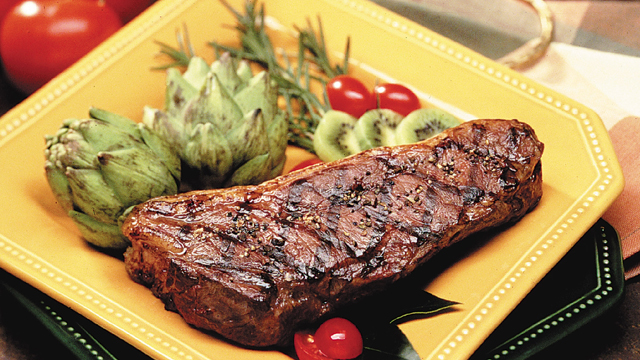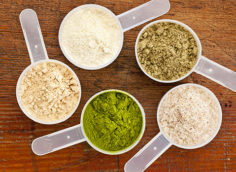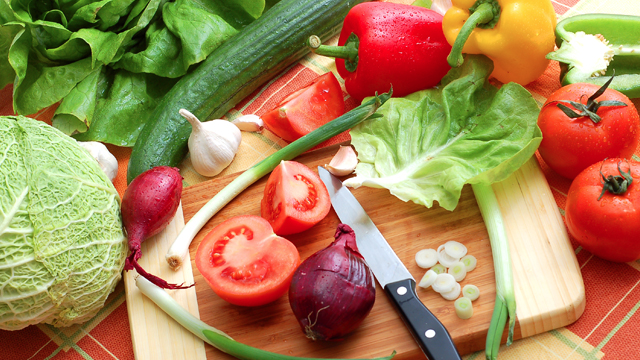I wish the formula for getting ripped were as easy as most traditional nutritionists would have you believe. Fat loss is just simple arithmetic, right? Subtract x from y, and boom, instant 8-pack.
That sure would make the fat loss game a hell of a lot easier. And best of all, Weight Watchers Centers would be like strip clubs, with the "points/calorie counting" process automatically turning every desperate housewife into a pole dancing bikini babe.
Imagine the world we could be living in if simple theories worked off paper, out there yonder, in the real world.
Now, I don't want to give you the wrong idea. Achieving a relative calorie deficit is still the most important piece of the fat loss puzzle – it's just not the only one. Of almost equal importance is understanding the metabolic and hormonal affects of food and then using that knowledge to develop a targeted plan of action.
The Importance of Insulin Sensitivity
I'd argue that the most important piece of the body composition transformation process is getting your body to use the hormone insulin more efficiently. 'Improved insulin sensitivity' should be the #1 goal on your Christmas wish list, but since it's spring; maybe you should throw a coin in a fountain instead.
Carbs and insulin can be a double-edged sword. Insulin is the most anabolic, anti-catabolic hormone in the body. It improves amino acid uptake by muscle tissue, which in turn initiates protein synthesis. It also prevents amino acids (from food or muscle) from being oxidized as a reserve fuel source.
On the flipside, it also can be the most lipolytic (fat storing) hormone in the body, shuttling fatty acids and glucose to fat cells to be stored as body fat.
These days, the majority of fat loss diets only focus on the negative side of insulin, which seems like a logical approach. You gotta go low-carb to minimize insulin release and lose fat, right? That's true, especially if you're overweight, sedentary, and likely insulin resistant – which today represents the majority of the population. The problem is, that's not a complete approach, especially for an athlete.
No hormone is inherently bad. For a leaner body that's training intensely and is in an overall calorie deficit, moderate amounts of insulin can actually be a good thing. And the leaner you get (trying to go from lean to shredded), the more you need to start thinking about the positive side of the insulin equation – insulin can help you maintain muscle while the overall dietary prescription continues to strip off fat.
That's why diets for sick, diabetic, sedentary office workers shouldn't be the same as those for active, lean-to-moderately-lean athletes. Cookie-cutting only works in the cookie making business.
The key is whether your body is insulin sensitive or insulin resistant. If your body is insulin sensitive, than you'll get more of the anabolic effects of insulin. Carbs can be higher in your diet. If your body is insulin resistant, than you'll get more of the lipolytic effects of insulin. Carbs should be lower in your diet.
Old school bodybuilding nutritionists (and even some of the newer-school ones advising natural athletes) say that a fat loss diet should be as high in carbs as an individual's body type and metabolism will allow. I couldn't agree more, though it's not the current trend of the low-carb lifestyle. Maybe instead of always focusing on cutting carbs, we should be trying to improve our body's ability to use them.
That means we need to get all of you a little more sensitive, so you can handle some damn carbs in your diet. Grab your chick flicks and bust out your Celine Dion collection, and lets get this sensitivity train rolling.

The Five-Step Insulin Sensitivity Approach
1 – Cut Out Fructose
Condemning all carbs as evil and cutting them across the board, regardless of the type or individual metabolic situation, is no different or more effective than the 1980s low fat approach. If pure starch really were the cause of insulin resistance and obesity, the Japanese would be the fattest, most diabetic people on Earth. Got rice?
Although the traditional Japanese diet is high in carbohydrate/starch, it's low in fructose/sugar, and that's the true anthropological lesson. It is abnormally high amounts of fructose that's causing widespread insulin resistance in America, not necessarily the generic carbohydrate.
According to numerous studies, fructose is the main culprit in table sugar that causes insulin resistance, not glucose. In animal models, fructose produced the following responses: insulin resistance, impaired glucose tolerance, high insulin levels, high triglycerides, and hypertension.
A study in the American Journal of Physiology compared a starch-based diet with a sucrose/fructose-based diet, with the practical application being this:
Cut out high fructose corn syrup, fructose sweeteners, sugar, fruit juice, fruit smoothies, and dried fruit. 1-2 pieces of whole fruit a day is permissible.(1)
Use glucose post-workout (Mag-10®) and fructose-free, gluten-free starch (rice and potatoes) as your primary carbohydrate sources.
2 – Cut Out Trans-Fats
Trans fats are horrendous for overall health. In the physique context, trans fats have been shown to inhibit glucose disposal, promote insulin resistance, and induce abdominal obesity.(2)
Practical application strategy: Cut out anything with trans fats or hydrogenated oils on the label.
3 – Improve Omega 6:3 Balance
We know the importance of correcting essential fatty acid balance for virtually all things health and fitness related. Insulin sensitivity is no exception.(3)
Practical application strategy: Increase intake of Omega-3 fatty acids through wild fish, grass-fed and finished beef, and/or supplement with Flameout®. Decrease your consumption of high Omega-6 vegetable oils such as corn oil, safflower oil, sunflower oil, and fried foods.
4 – Grab a Green Tea
You've heard of glucose disposal agents, right? Green tea is one of them. According to a study in Biofactors, "For mechanisms of the anti-obesity actions, green tea significantly reduced glucose uptake accompanied by a decrease in translocation of glucose transporter 4 (GLUT4) in adipose tissue, while it significantly stimulated the glucose uptake with GLUT4 translocation in skeletal muscle."(4)
More carbs being diverted towards muscle cells and away from fat cells? They don't call me Mr. Teabagger for nothing.
5 – Be Nice With Cinnamon Spice
Cinnamon is another food compound that has shown to exhibit positive nutrient partitioning effects. Numerous studies have shown it to improve the metabolic action of insulin resistance by increasing glucose uptake by the cells and enhancing the insulin-signaling pathway in muscle.(5)
The last time I checked about 1/4 of the U.S. population was pre-diabetic. If you're over 25% body fat, chances are you could be among that group. So one particular study that stood out: cinnamon extract that was given to 21 adults with pre-diabetes led to a 1.1% increase in muscle mass and a 0.7% decrease in body fat, without exercise. (6)
That may not sound like much, but combine that with some strength training and the previous four steps, and you have a multi-faceted attack on La (Insulin) Resistance. A formidable foe requires a team effort.
And on a side note, that's no excuse to go out and start pounding down Churros or Cinnamon Toast Crunch (my personal favorite as a kid). It has to be high quality stuff without the junk to have an effect.
6th Sensitive Man of the Year Award
So you have your starting 5, crybaby line-up. But who's coming off the bench to hit the game-winning shot? It's your diet of course – the most important piece of this sensitivity makeover.
Find Your Place on the Dietary Seesaw
If you're obese, low carb diets are the best way to go to lose fat – you're so insulin resistant that any carbohydrates you eat will most likely be stored in adipose tissue. Sorry. Research shows that the best approach for this demographic to improve insulin sensitivity is to lose body fat through low-carb eating. Once you're lean, you'll have more dietary options.
However, research has also shown that prolonged low-carb eating may reduce insulin sensitivity. Can you say "post-dieting or post-contest weight rebound"? This may be due to enzymatic changes in the body (for example, pyruvate dehydrogenase activation – a key enzyme in carbohydrate metabolism – is reduced after prolonged periods of low carbohydrate intake). Use it or lose it, I guess?
I don't like to get caught up in the confines of any one, universal dietary "system." I prefer instead to draw from different approaches based on the individual's unique situation.
For carbohydrate intake, I look at it as a seesaw approach. On one side, you have a person's relative insulin resistance, on the other side, their suggested carbohydrate intake.
If someone's insulin resistance level is high, then his/her carbohydrate intake should be low. If someone's insulin resistance level is low (and insulin sensitivity is high), then his/her carbohydrate intake should be high. If it's in the middle, carbohydrates should be moderate and targeted.
Practical application strategy – Since insulin resistance is closely correlated with body fat, we'll put it in terms of ballpark body fat percentages:
>25% body fat: Low-carb diets would be the best. Think Paleo, Caveman, LaLanne's "if man made it don't eat it", or Poliquin's "run, fly, swim, green and grows in the ground" approach.
12-25% body fat: Stick with the "earn your carbs" theme. If you're consistently strength training like a madman, you can reintroduce carbs back into your diet. Start slowly, perhaps 0.75-1.0g/lb of lean body mass. Targeted timing matters – spread intake over periods where insulin sensitivity is at its highest (peri-workout and breakfast).
<10% body fat: In addition to peri-workout nutrition and breakfast, I think carbs should be a consistent part of the diet for this demographic. Something like a traditional bodybuilding high protein, moderate-to-high carb, lower fat, with fat as a by-product of protein sources approach. I would go with 1-2 grams protein per pound of lean body mass spread relatively evenly over the course of the day.
Hugs Anyone?
With this article in hand, all of you should be on your way to being a little more (insulin) sensitive. If you happen to be a hot figure athlete and want to give me a hug right now, I will accept. If you're a dude and want to do the same thing, I appreciate the gesture, but unfortunately we're going to have to settle for, as Borat would say, a "High-five. Very nice."
References
- Thresher et al, Comparison of the effects of sucrose and fructose on insulin action and glucose tolerance. AJP- Regu Physiol October 2000 vol.279 no.4
- Kavanagh et al, Trans fat diet induces abdominal obesity and changes in insulin sensitivity in monkeys. Obesity 2007 Jul;15(7):1675-84.
- Gonzalez-Periz et al, Obesity-induced insulin resistance and hepatic steatosis are alleviated by omega-3 fatty acids: a role for resolvins and protectins. FASEB J. 2009 Jun; 23(6):1946-57
- Ashida et al, Anti-obesity actions of green tea: Possible involvements in modulation of the glucose uptake system and suppression of the adipogenesis-related transcription factors. Biofactors 2004; 22(1-4):135-40.
- Qin, B, et al. Cinnamon extract potentiates in vivo insulin-regulated glucose utilization via enhancing insulin signaling in rats. Diabetes Research and Clinical Practice 2003 62:139-148.
- Ziegenfuss, TN, et al. Effects of a proprietary water-soluble extract on metabolic syndrome. Diabetes Care, 2006.





